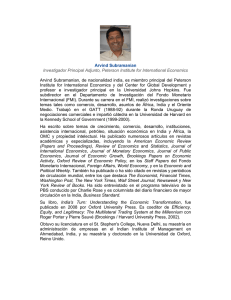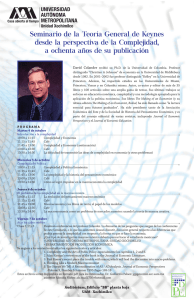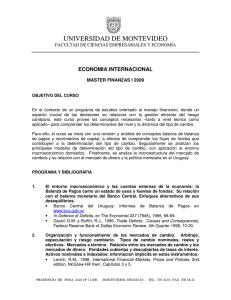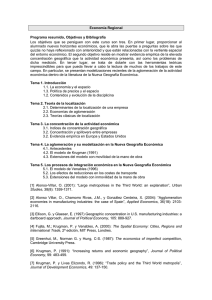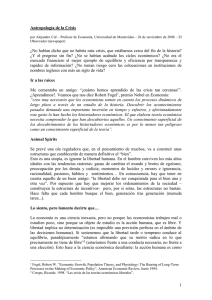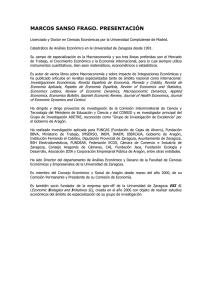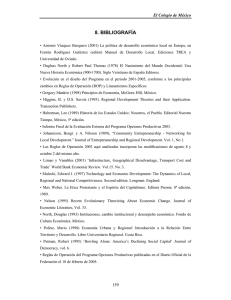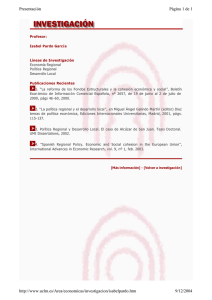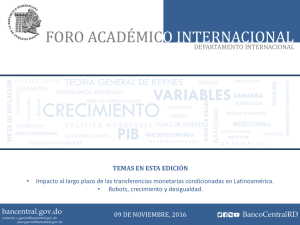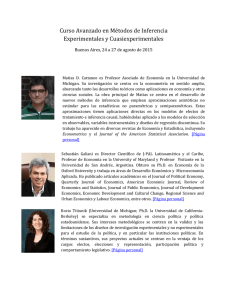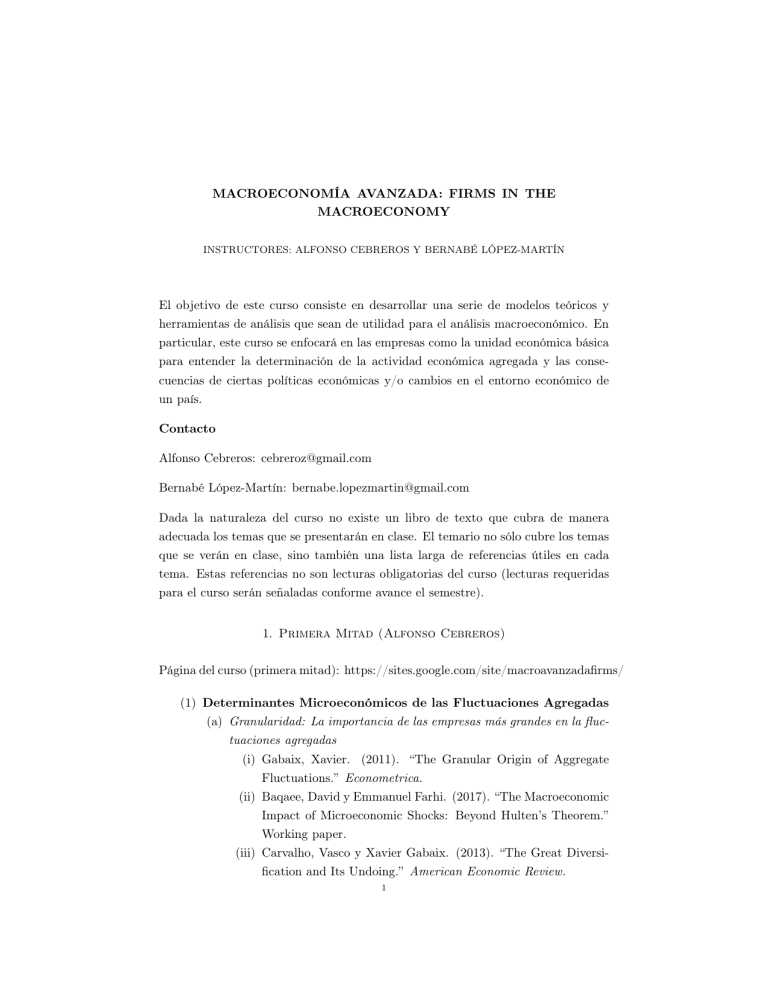
MACROECONOMÍA AVANZADA: FIRMS IN THE MACROECONOMY INSTRUCTORES: ALFONSO CEBREROS Y BERNABÉ LÓPEZ-MARTÍN El objetivo de este curso consiste en desarrollar una serie de modelos teóricos y herramientas de análisis que sean de utilidad para el análisis macroeconómico. En particular, este curso se enfocará en las empresas como la unidad económica básica para entender la determinación de la actividad económica agregada y las consecuencias de ciertas políticas económicas y/o cambios en el entorno económico de un país. Contacto Alfonso Cebreros: [email protected] Bernabé López-Martín: [email protected] Dada la naturaleza del curso no existe un libro de texto que cubra de manera adecuada los temas que se presentarán en clase. El temario no sólo cubre los temas que se verán en clase, sino también una lista larga de referencias útiles en cada tema. Estas referencias no son lecturas obligatorias del curso (lecturas requeridas para el curso serán señaladas conforme avance el semestre). 1. Primera Mitad (Alfonso Cebreros) Página del curso (primera mitad): https://sites.google.com/site/macroavanzadafirms/ (1) Determinantes Microeconómicos de las Fluctuaciones Agregadas (a) Granularidad: La importancia de las empresas más grandes en la fluctuaciones agregadas (i) Gabaix, Xavier. (2011). “The Granular Origin of Aggregate Fluctuations.” Econometrica. (ii) Baqaee, David y Emmanuel Farhi. (2017). “The Macroeconomic Impact of Microeconomic Shocks: Beyond Hulten’s Theorem.” Working paper. (iii) Carvalho, Vasco y Xavier Gabaix. (2013). “The Great Diversification and Its Undoing.” American Economic Review. 1 MACROECONOMÍA AVANZADA: FIRMS IN THE MACROECONOMY 2 (iv) Di Giovanni, Julian. Andrei A. Levchenko e Isabelle Mejean. (2014). “Firms, Destinations, and Aggregate Fluctuations.” Econometrica. (v) Di Giovanni, Julian y Andrei A. Levchenko. (2012). “Country Size, International Trade, and Aggregate Fluctuations in Granular Economies.” Journal of Political Economy. (vi) Freund, Caroline y Martha Denisse Pierola. (2015). “Export Superstars.” The Review of Economics and Statistics. (vii) Alessandria, George. Horag Choi, Joseph P. Kaboski y Virgilio Midrigan. (2015). “Microeconomic uncertainty, international trade, and aggregate fluctuations.” Journal of Monetary Economics. (viii) Barrot, Jean- Nöel y Julien Sauvagnat. (2016). “Input Specificity and the Propagation of Idiosyncratic Shocks in Production Networks.” Quarterly Journal of Economics. (b) La composición sectorial de la economía y las fluctuaciones agregadas (i) Shea, John. (2002). “Complementarities and Comovements.” Journal of Money, Credit, and Banking. (ii) Foerster, Andrew. Pierre-Daniel G. Sarte y Mark W. Watson. (2011). “Sectoral versus Aggregate Shocks: A Structural Factor Analysis of Industrial Production.” Journal of Political Economy. (iii) Acemoglu, Daron. Vasco M. Carvalho, Asuman Ozdaglar y Alireza Tahbaz-Salehi. (2012). “The Network Origins of Aggregate Fluctuations.” Econometrica. (iv) Atalay, Enghin. (2017). “How Important Are Sectoral Shocks?” American Economic Journal: Macroeconomics. (v) Garin, Julio. Michael J. Pries y Eric R. Sims. (2018). “The Relative Importance of Aggregate and Sectoral Shocks and the Changing Nature of Economic Fluctuations.” American Economic Journal: Macroeconomics. (vi) Caliendo, Lorenzo. Fernando Parro, Esteban Rossi-Hansberg y Pierre-Daniel Sarte. (2016). “The Impact of Regional and Sectoral Productivity Changes on the U.S. Economy.” Review of Economic Studies (forthcoming). (2) Modelos de comercio con empresas heterogéneas (a) Modelos Básicos: Competencia Monopolística y Preferencias CES (i) Capítulo 6. Feenstra, Robert C. (2015). Advanced International Trade. Segunda Edición. Princeton University Press. MACROECONOMÍA AVANZADA: FIRMS IN THE MACROECONOMY 3 (ii) Dixit, Avinash y Joseph E. Stiglitz. (1977). “Monopolistic Competition and Optimum Product Diversity.” American Economic Review. (iii) Krugman, Paul. (1980). “Scale Economies, Product Differentiation, and the Pattern of Trade.” American Economic Review. (b) Modelos con empresas heterogéneas (i) Bernard, Andrew B. J. Bradford Jensen, Stephen J. Redding y Peter K. Schott. (2007). “Firms in International Trade.” Journal of Economic Perspectives. (ii) Melitz, Marc. (2003). “The Impact of Trade on Intra-industry Reallocations and Aggregate Industry Productivity.” Econometrica. (iii) Melitz, Marc y Stephen J. Redding. (2015). “Heterogeneous Firms and Trade.” Handbook of International Economics, Volume 4. (c) Aplicaciones (i) Melitz, Marc y Stephen J. Redding. (2015). “New Trade Models, New Welfare Implications.” American Economic Review. (ii) Hsieh, Chang-Tai y Ralph Ossa. (2016). “A Global View of Productivity Growth in China.” Journal of International Economics. (iii) Melitz, Marc. Elhanan Helpman y Stephen Yeaple. (2004). “Exports versus FDI with Heterogeneous Firms.” American Economic Review. (iv) Melitz, Marc y Fabio Ghironi. (2005). “International Trade and Macroeconomic Dynamics with Heterogeneous Firms.” Quarterly Journal of Economics. (v) Cravino, Javier y Andrei A. Levchenko. (2017). “Multinational Firms and International Business Cycle Transmission.” Quarterly Journal of Economics. 2. Segunda Mitad (Bernabé López-Martín) (1) Introducción (a) Banerjee, A.V. y E. Duflo. (2005). Growth Theory through the Lens of Development Economics. Handbook of Economic Growth, Chapter 7, Volume 1A. (b) Jones, C.I. (2015). “The Facts of Economics Growth.” NBER WP 21142. MACROECONOMÍA AVANZADA: FIRMS IN THE MACROECONOMY 4 (c) Restuccia, D. y R. Rogerson. (2017). “The Causes and Costs of Misallocation.” Journal of Economic Perspectives. (2) “Misallocation”: Teoría y Evidencia Empírica (a) Hsieh, C.T. y P.J. Klenow. (2009). “Misallocation and Manufacturing TFP in China and India.” Quarterly Journal of Economics. (b) Hsieh, C.T. y P.J. Klenow (2014). “The Life Cycle of Plants in India and Mexico.” Quarterly Journal of Economics. (c) Restuccia, D. y R. Rogerson. (2008). “Policy distortions and aggregate productivity with heterogeneous establishments.” Review of Economic Dynamics. (3) Bienes Intermedios y Productividad Agregada (a) Amodio, F. y M. Di Maio (2017). “Making Do With What You Have: Conflict, Input Misallocation and Firm Performance.” The Economic Journal. (b) Grobovsek, J. (2017). “Development Accounting with Intermediate Goods.” B.E. Journal of Macroeconomics (forthcoming). (c) Jones, C.I. (2011). “Intermediate Goods and Weak Links in the Theory of Economic Development.” American Economic Journal: Macroeconomics. (d) Levine, D.K. (2012). “Production chains.” Review of Economic Dynamics. (4) Fricciones Financieras y “Misallocation” (y Productividad Endógena) (a) Caselli, F. y N. Gennaioli. (2013). “Dynastic Management.” Economic Inquiry. (b) Gorodnichenko, Y. y M. Schnitzer. (2013). “Financial Constraints and Innovation: Why Poor Countries Don’t Catch Up.” Journal of the European Economic Association. (c) Lopez-Martin, B. (2016). “From Firm Productivity Dynamics to Aggregate Efficiency.” World Bank Economic Review (ABCDE Conference Proceedings). (d) Lopez-Martin, B. (2016). “Informal Sector Misallocation.” Documento de Investigación Banco de México 2016-09. (e) Midrigan, V. y D.Y. Xu. (2010). “Finance and Misallocation: Evidence from Plant-level Data.” NBER Working paper 15647. (5) Instituciones, Empresas y Productividad Agregada (a) Acemoglu, D., P. Antras y E. Helpman. (2007). “Contracts and Technology Adoption.” American Economic Review. MACROECONOMÍA AVANZADA: FIRMS IN THE MACROECONOMY 5 (b) Amirapu, A. y M. Gechter. “Labor Regulations and the Cost of Corruption: Evidence from the Indian Firm Size Distribution.” Working paper. (c) Bachas, P., R.N. Fattal Jaef y A. Jensen. “Size-Dependent Tax Enforcement and Compliance.” World Bank, Policy Research Working Paper 8363. (d) Guner, N., G. Ventura y Y. Xu (2008). “Macroeconomic implications of size-dependent policies.” Review of Economic Dynamics. (e) Hill, E. y D. Perez-Reyna (2015). “Public Law Enforcement: More is not Always Better.” Working paper. (f) Lopez, J.J. (2017). “A quantitative theory of tax evasion.” Journal of Macroeconomics. (g) Martin, L.A., S. Nataraj y A. Harrison (2017). “In with the Big, Out with the Small: Removing Small-Scale Reservations in India.” American Economic Review. (h) Misch, F. y C. Saborowski (2018). “Resource Misallocation and Productivity: Evidence from Mexico.” IMF WP/18/112. (i) Nunn, N. (2007). “Relationship-Specificity, Incomplete Contracts, and the Pattern of Trade.” Quarterly Journal of Economics. (j) Ranasinghe, A. (2017). “Property Rights, Extortion and the Misallocation of Talent.” European Economic Review. (k) Sanchez-Vela, C. y J.N. Valero-Gil (2011). “The effect of firm-size dependent policies on the economy: the case of the Repecos law in Mexico.” IDB WP-216. (l) Ulyssea, G. (2018). “Firms, Informality and Development: Theory and Evidence from Brazil.” American Economic Review. (6) “Misallocation” en Agricultura (a) Adamopoulos, T., L. Brandt, J. Leight y D. Restuccia (2016). “Misallocation, Selection, and Productivity: A Quantitative Analysis with Panel Data from China.” Working paper. (b) Adamopoulos, T. y D. Restuccia (2014). “The Size Distribution of Farms and International Productivity Differences.” American Economic Review. (c) Chari, A.V., E.M. Liu, S.Y. Wang y Y. Wang (2017). “Property Rights, Land Misallocation and Agriculture Efficiency in China.” NBER WP 24099. (d) Gollin, D., S. Parente y R. Richardson (2002). “The Role of Agriculture in Development.” American Economic Review. MACROECONOMÍA AVANZADA: FIRMS IN THE MACROECONOMY 6 (e) Gottlieb, C. y J. Grobovsek (2016). “Communal Land and Agricultural Productivity.” Working paper. (f) Lagakos, D. y M.E. Waugh (2013). “Selection, Agriculture, and CrossCountry Productivity Differences.” American Economic Review. (g) Restuccia, D., D.T. Yang y X. Zhu (2008). “Agriculture and aggregate productivity: A quantitative cross-country analysis.” Journal of Monetary Economics. (7) Tópicos en Productividad Agregada y de la Firma (a) Atkin, D., A. Chaudry, S. Chaudry, A.K. Khandelwal y E. Verhoogen (2017). “Organizational Barriers to Technology Adoption: Evidence from Soccer-ball Producers in Pakistan.” Quarterly Journal of Economics. (b) Zingales, L. (2017). “Towards a Political Theory of the Firm.” Journal of Economic Perspectives.
